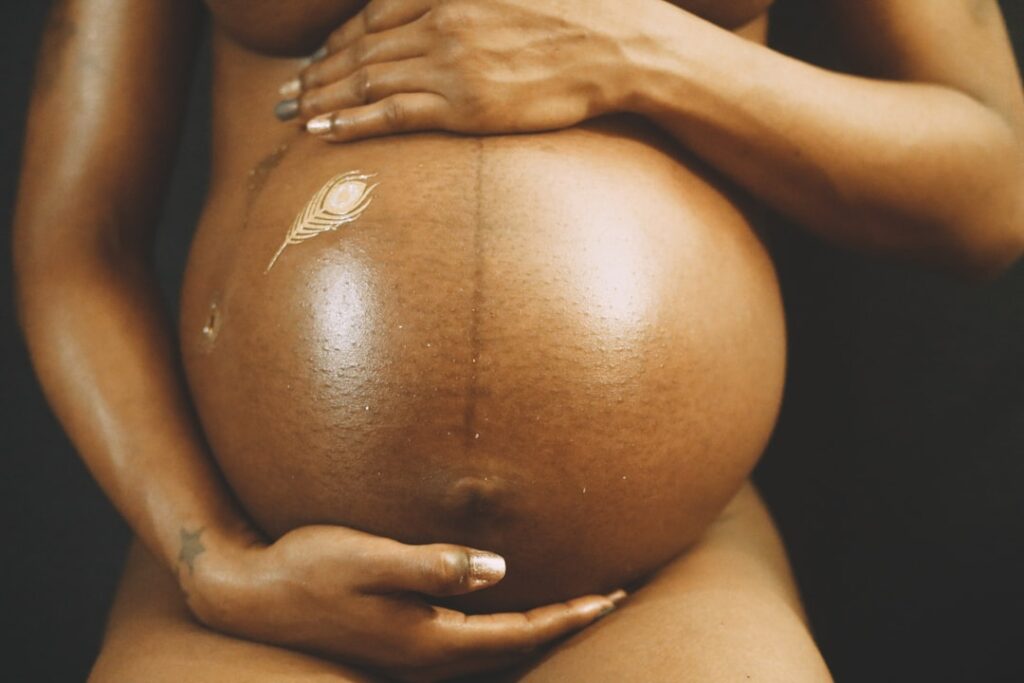Why Safe Skincare for Pregnancy Matters More Than Ever
Safe skincare for pregnancy becomes a top priority the moment you see those two pink lines. Your body is creating new life, and suddenly every product you put on your skin matters more than ever before.
Quick Answer for Safe Pregnancy Skincare:
- Safe ingredients: Vitamin C, niacinamide, azelaic acid, hyaluronic acid, mineral sunscreens
- Avoid completely: Retinoids, high-dose salicylic acid, hydroquinone, chemical sunscreens
- Key rule: When in doubt, consult your doctor
- Best approach: Keep it simple with gentle, proven ingredients
Pregnancy brings a whirlwind of changes – and your skin is along for the ride. Hormonal shifts can trigger everything from the coveted “pregnancy glow” to unexpected breakouts, melasma, and increased sensitivity. Meanwhile, you’re navigating a maze of conflicting advice about which products are safe.
The placenta screens out some substances but allows many others to pass through to your developing baby. This means ingredients that were perfectly fine before pregnancy may now pose risks. Research shows that certain compounds like hydroquinone can be absorbed at rates of 35-45% through the skin, while retinoids have been linked to birth defects in clinical studies.
But here’s the good news: you don’t need to abandon skincare entirely. Many effective, gentle ingredients can help you maintain healthy skin throughout your pregnancy journey. The key is knowing which ones to accept and which to avoid.
This guide will decode the science behind pregnancy skincare safety, giving you clear, research-backed answers so you can care for your skin with confidence.
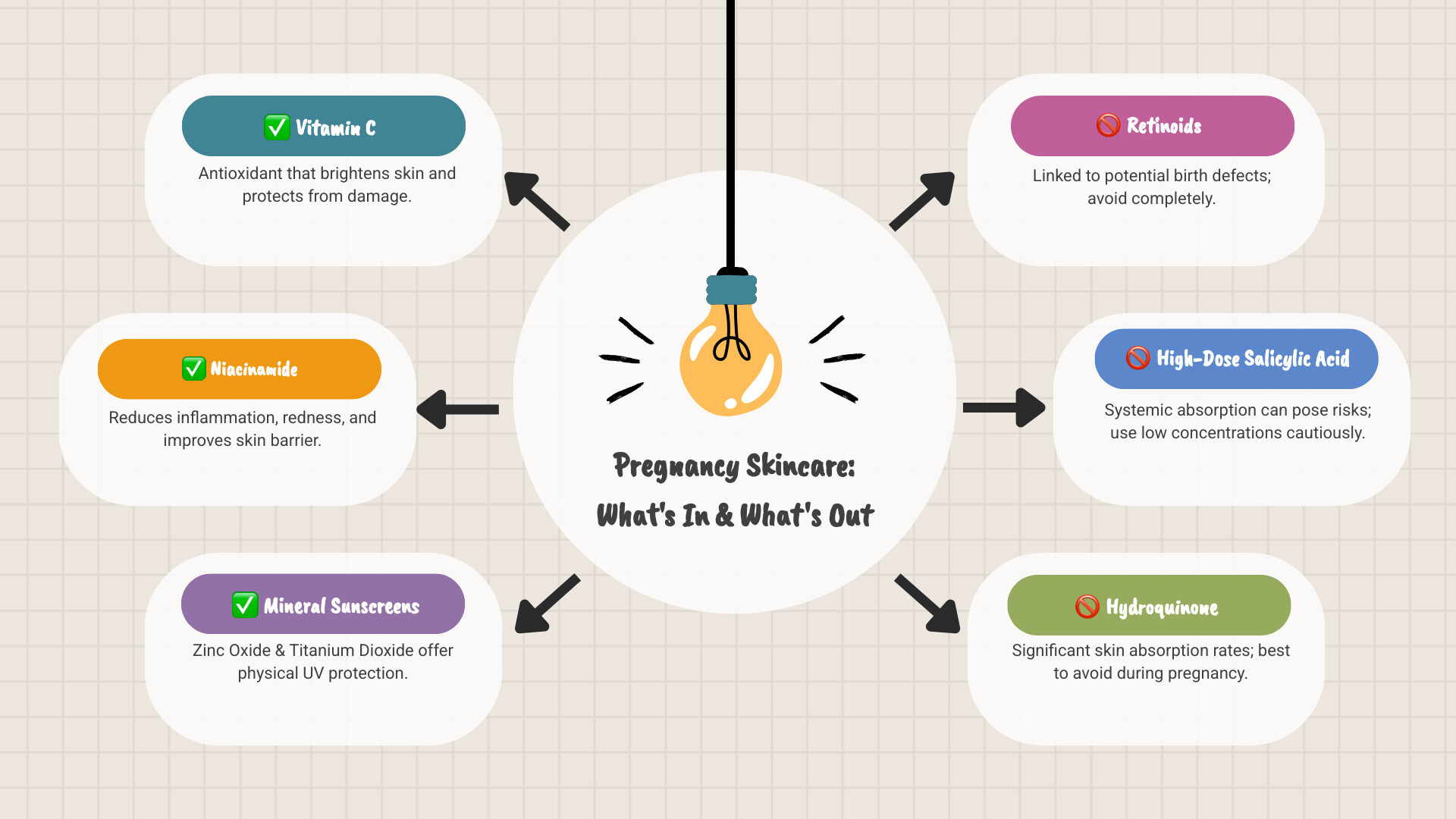
Quick look at Safe skincare for pregnancy:
Your Skin on Pregnancy: Common Changes and What They Mean
Pregnancy is a transformative journey, and your skin often reflects these profound internal changes. While some lucky individuals might experience the fabled “pregnancy glow,” many of us encounter a range of new or exacerbated skin concerns. These changes are primarily driven by the significant hormonal fluctuations that occur, particularly increases in androgen levels.
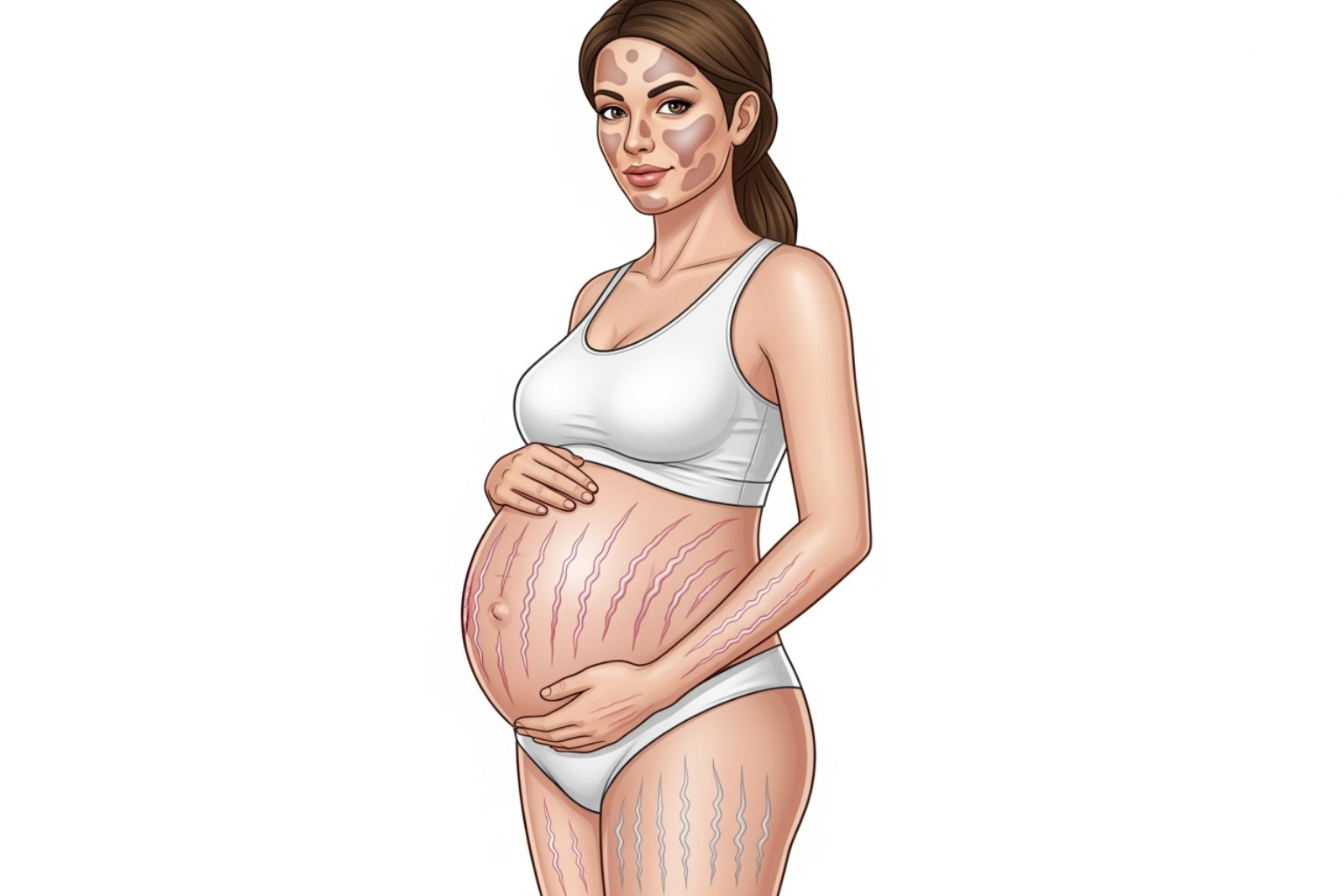
Here’s a closer look at what you might experience:
- Hormonal Fluctuations: Your body’s endocrine system goes into overdrive, leading to shifts in estrogen, progesterone, and androgen levels. These hormonal shifts can influence everything from oil production to pigmentation.
- The “Pregnancy Glow”: For some, increased blood volume and circulation bring a healthy flush to the skin, making it appear radiant. This is often accompanied by a temporary plumping effect.
- Pregnancy Acne: Ah, the unwelcome return of breakouts! Increased androgen levels can stimulate sebaceous glands, leading to excess oil production and clogged pores. This can result in new or worsening acne, often reminiscent of adolescent skin. If you’re struggling with hormonal breakouts, we have resources on How to Treat Hormonal Acne Naturally.
- Melasma (“Mask of Pregnancy”): This common concern manifests as dark, splotchy patches on the face, often on the forehead, cheeks, and upper lip. It’s caused by increased melanin production stimulated by pregnancy hormones and sun exposure.
- Hyperpigmentation: Beyond melasma, you might notice other areas of skin darkening, such as the linea nigra (a dark line down the abdomen), darkened nipples, or freckles and moles that appear more prominent. We offer insights into Natural Remedies for Hyperpigmentation on Face that might be helpful.
- Increased Skin Sensitivity: Your skin might become more reactive to products you once loved, leading to redness, itching, or irritation.
- Stretch Marks (Striae Gravidarum): As your body expands to accommodate your growing baby, the elastic fibers in your skin can stretch and sometimes tear, resulting in pink, red, or purple lines. While genetics play a significant role, keeping the skin well-hydrated can help with suppleness and itching.
Understanding these common changes is the first step in building a safe skincare for pregnancy routine that addresses your specific needs without compromising your health or your baby’s.
The Green List: Skincare Ingredients Generally Considered Safe
Finding ingredients you can trust during pregnancy doesn’t have to feel overwhelming. Think of this as your “green light” collection – these are the skincare heroes that dermatologists and pregnancy experts consistently recommend as both safe and effective.
Azelaic acid tops our list for good reason. This gentle powerhouse tackles multiple concerns at once, fighting acne while brightening dark spots and calming inflammation. It’s particularly brilliant for melasma, which makes it a pregnancy skincare superstar. The American College of Obstetricians and Gynecologists gives it their stamp of approval, so you can use it with confidence.
When it comes to gentle exfoliation, glycolic acid and lactic acid are your friends – but only in low doses. These alpha hydroxy acids help reveal brighter, smoother skin without the risks associated with stronger treatments. Look for products with 10% or less concentration, which you’ll find in most over-the-counter formulas.
Vitamin C deserves a standing ovation for pregnancy skincare. This antioxidant champion brightens your complexion, protects against environmental damage, and helps maintain that healthy glow we’re all after. It’s completely safe and works beautifully with other pregnancy-approved ingredients.
Niacinamide (also called Vitamin B3) is like having a Swiss Army knife in your skincare routine. It reduces redness, minimizes pores, and strengthens your skin barrier – all while being incredibly gentle. Paired with vitamin C, it creates a powerful brightening duo that’s much safer than hydroquinone.
For hydration that goes the distance, hyaluronic acid is absolutely essential. This moisture magnet can hold up to 1,000 times its weight in water, keeping your skin plump and comfortable. During pregnancy, when your skin might feel drier than usual, this ingredient is pure gold.
Peptides offer anti-aging benefits without any pregnancy concerns. These amino acid chains support your skin’s natural collagen and elastin production, helping maintain firmness and reducing fine lines naturally.
If you’re missing your retinol, meet bakuchiol – nature’s gentle alternative. This plant-derived ingredient offers similar anti-aging benefits without any of the pregnancy risks. It’s been gaining serious attention in the skincare world, and for good reason. Check out our Ingredient Spotlight Why Everyone’s Talking About Bakuchiol to learn more about this game-changing ingredient.
Finally, mineral sunscreens with zinc oxide and titanium dioxide are absolutely non-negotiable for safe skincare for pregnancy. These physical blockers sit on top of your skin, deflecting UV rays rather than absorbing them like chemical sunscreens do. They’re your best defense against melasma and sun damage, and they’re completely safe for you and baby. The ACOG’s skincare recommendations emphasize just how important mineral sun protection is during this time.
These ingredients form the backbone of effective, worry-free pregnancy skincare. They address real concerns while keeping safety as the top priority – exactly what you need during this special time.
The Red List: Skincare Ingredients to Avoid During Pregnancy
Understanding what to avoid is just as crucial as knowing what’s safe. When you’re expecting, your body becomes incredibly protective of your growing baby – but some ingredients can still slip through the cracks.
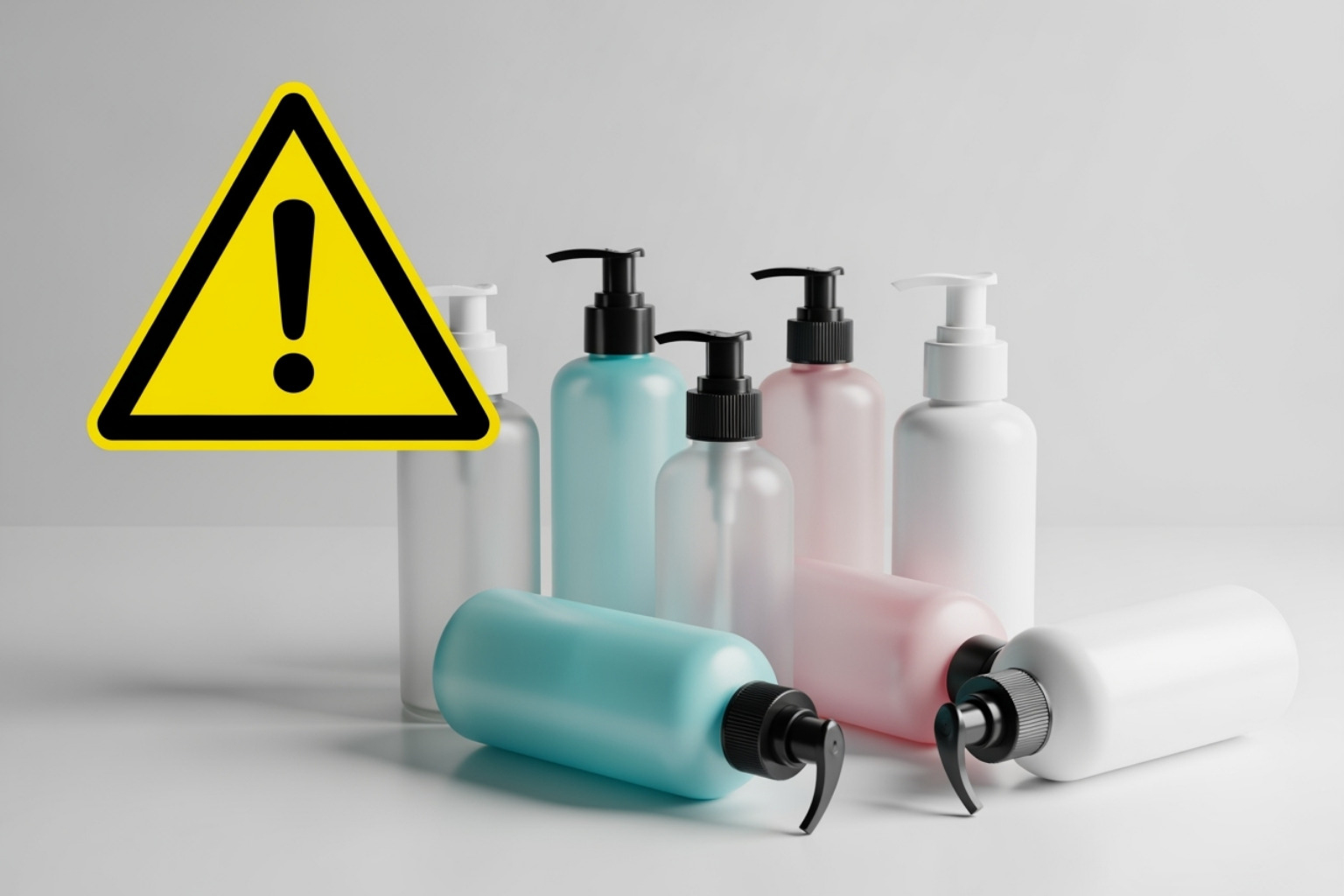
The FDA uses a letter system (A through X) to categorize ingredients based on pregnancy safety. Think of it like a report card – A and B are your friends, while C, D, and X spell trouble. The main concern? Systemic absorption – when ingredients absorb through your skin and enter your bloodstream, potentially reaching your baby.
Here’s where things get tricky. Your skin isn’t an impermeable barrier. Some ingredients can be absorbed at surprisingly high rates, and during pregnancy, even small amounts of certain compounds can pose risks to fetal development.
Ingredients to Avoid
Retinoids top our avoid-at-all-costs list. Whether it’s Retin-A, tretinoin, retinol, or retinyl palmitate, these vitamin A derivatives are pregnancy skincare enemy number one. Oral forms like Accutane are notorious for causing severe birth defects – they’re classified as Category X, meaning the risks clearly outweigh any benefits.
But here’s what surprises many people: even topical retinoids carry risks. While absorption through skin is lower than oral intake, case reports have linked topical tretinoin to birth defects. Since we can’t predict how much your skin will absorb, the safest approach is avoiding all retinoids entirely.
High-dose salicylic acid presents another concern for safe skincare for pregnancy. Low concentrations (2% or less) in face washes are generally fine because they rinse off quickly. But high-dose treatments like chemical peels? Skip them. Salicylic acid is chemically similar to aspirin, and high doses during pregnancy can cause complications.
Hydroquinone might seem tempting for treating pregnancy-related dark spots, but resist the urge. This bleaching agent has a whopping 35-45% absorption rate through skin. With limited safety data and such high systemic absorption, it’s not worth the risk when safer alternatives exist.
Phthalates are the sneaky villains hiding in your products. Often listed simply as “fragrance,” these endocrine disruptors can interfere with your hormone systems – exactly what you don’t want during pregnancy. Studies link phthalate exposure to reproductive and developmental issues.
Formaldehyde and its releasing chemicals are another group to dodge. While rarely used directly anymore, formaldehyde-releasers like DMDM hydantoin and quaternium-15 still lurk in some cosmetics. The CDC has linked formaldehyde to increased miscarriage risk and fertility problems.
Chemical sunscreens, particularly oxybenzone, raise red flags too. Animal studies suggest oxybenzone exposure during pregnancy can cause permanent changes to mammary glands and potentially harm fetal development. Since mineral sunscreens work just as well, why take the chance?
For detailed research on these ingredients, check out this comprehensive Safety of skin care products during pregnancy research. And if ingredient labels look like hieroglyphics to you, our guide Beyond the Label How to Read Clean Beauty Ingredients Like a Pro can help decode them.
| Ingredient to Avoid | Why It’s Harmful / Risk | Safe Alternatives |
|---|---|---|
| Retinoids (Retinol, Tretinoin, etc.) | High risk of birth defects, liver toxicity (especially oral forms) | Bakuchiol, Peptides, Vitamin C |
| High-Dose Salicylic Acid | Potential fetal risk at high concentrations, similar to aspirin | Low-dose Salicylic Acid (wash-off), Azelaic Acid, Glycolic Acid (low-dose) |
| Hydroquinone | High systemic absorption (35-45%), limited safety data | Vitamin C, Niacinamide, Azelaic Acid |
| Phthalates (often in “fragrance”) | Endocrine disruptors, linked to reproductive/developmental issues | Fragrance-free products, natural fragrances from essential oils (with caution) |
| Formaldehyde and Releasers | Carcinogen, linked to infertility/miscarriage | Products free of DMDM hydantoin, quaternium-15, etc. |
| Chemical Sunscreens (Oxybenzone) | Endocrine disruptor, animal studies show potential fetal harm | Mineral Sunscreens (Zinc Oxide, Titanium Dioxide) |
Pregnancy is temporary, but your baby’s health is forever. When building your safe skincare for pregnancy routine, it’s always better to err on the side of caution.
Your Guide to Safe Skincare for Pregnancy: Building a Routine
Creating a safe skincare for pregnancy routine might feel overwhelming at first, but here’s some reassuring news: simpler is actually better during this time. Your skin is already navigating a rollercoaster of hormonal changes, so the last thing it needs is a complicated 12-step routine that could trigger unexpected reactions.
The beauty of pregnancy skincare lies in its minimalist approach. Think of it as giving your skin exactly what it needs without any unnecessary extras. This strategy not only reduces the risk of irritation but also makes your daily routine more manageable when you’re dealing with morning sickness or pregnancy fatigue.
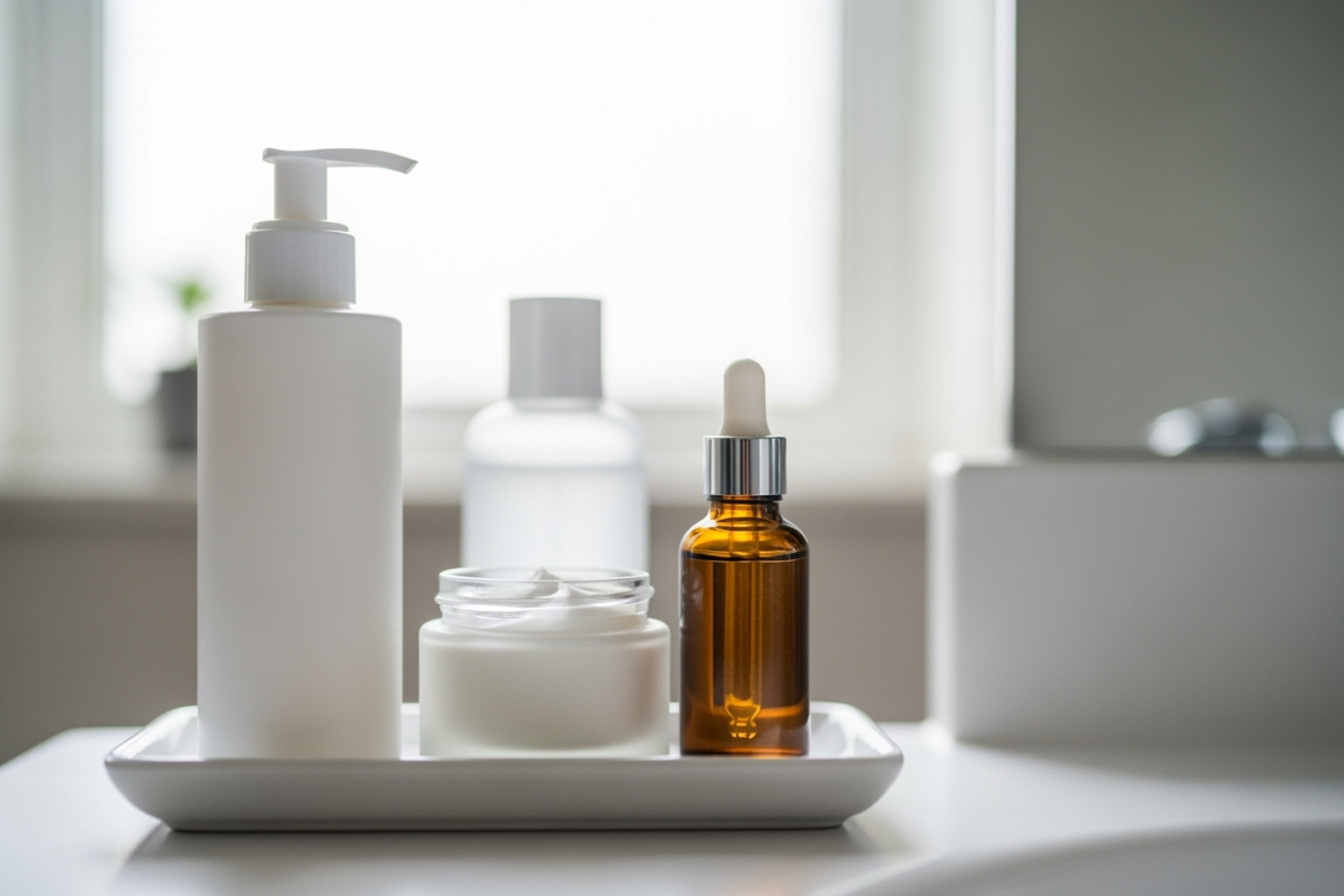
Before diving into any new routine, there’s one crucial step that becomes even more important during pregnancy: patch testing. Even ingredients considered completely safe can sometimes cause reactions when your skin is more sensitive than usual. Test any new product on a small patch of skin behind your ear or on your inner wrist, then wait 24-48 hours to see how your skin responds.
For guidance on combining your chosen products effectively, our comprehensive guide on How to Layer Skincare Products Correctly can help you maximize their benefits.
Your Daily Safe Skincare for Pregnancy Routine
Building your daily routine around four essential steps creates a solid foundation for healthy skin throughout your pregnancy journey.
Gentle cleansers form the cornerstone of your morning and evening routine. Look for non-foaming, fragrance-free formulas specifically designed for sensitive skin. These cleansers remove daily impurities, makeup, and sunscreen without stripping away your skin’s protective moisture barrier – something that becomes especially important when pregnancy hormones are already affecting your skin’s balance.
Hydrating serums come next, with hyaluronic acid being your best friend during this time. This powerhouse ingredient can hold up to 1,000 times its weight in water, drawing moisture deep into your skin layers. The result? Plumper, more supple skin that’s better equipped to handle the stretching and changes happening during pregnancy.
Nourishing moisturizers seal in all that hydration while providing additional comfort to skin that might feel tighter or drier than usual. Ingredients like ceramides and squalane support your skin’s natural barrier function, helping it retain moisture throughout the day and night.
Mineral-based sunscreen is absolutely non-negotiable for your morning routine. Rain or shine, indoors or out, broad-spectrum protection with zinc oxide and titanium dioxide shields your skin from UV damage. This step is particularly crucial for preventing melasma from worsening or developing in the first place. Our detailed exploration of The Importance of Sunscreen explains why this step deserves top priority in your routine.
Targeting Common Concerns with Safe Skincare for Pregnancy
Pregnancy brings unique skin challenges, but safe skincare for pregnancy offers effective solutions for each concern.
Acne treatments during pregnancy require a different approach than your pre-pregnancy routine. Azelaic acid becomes your new acne-fighting hero, offering powerful anti-inflammatory benefits without the risks associated with retinoids. For gentle exfoliation, low-dose glycolic acid or lactic acid cleansers can help keep pores clear without over-drying your skin.
Melasma prevention starts with religious sun protection – your mineral sunscreen isn’t just preventing general sun damage, it’s actively working to prevent those dark patches from forming or deepening. Complement this protection with vitamin C and niacinamide in your routine. These ingredients work together beautifully to brighten existing discoloration and prevent new dark spots from forming, offering a safe alternative to hydroquinone.
Stretch mark care focuses on keeping your rapidly changing skin as supple as possible. While genetics play the biggest role in whether you’ll develop stretch marks, maintaining excellent hydration can help your skin stretch more comfortably. Rich moisturizers containing shea butter, cocoa butter, or hyaluronic acid provide the deep nourishment your skin craves. Don’t forget the power of gentle massage – regularly massaging areas prone to stretch marks like your belly, hips, and breasts can support skin elasticity while providing a moment of self-care in your day.
Soothing sensitive skin sometimes means taking your minimalist approach even further. If your usual gentle products suddenly feel irritating, strip back to the absolute basics: a simple, fragrance-free cleanser and a basic moisturizer. Look for calming ingredients like colloidal oatmeal or bisabolol to help reduce reactivity. Our insights on Clean Beauty Sensitive Skin offer additional strategies for managing increased sensitivity during this special time.
Beyond the Bottle: Professional Treatments and Expert Advice
When it comes to safe skincare for pregnancy, your home routine is just the beginning. The moment you see those two pink lines, it’s time to take a closer look at everything in your skincare arsenal – and that includes professional treatments you might be considering.
Auditing your current routine should be your first step. Pull out every product you use, from cleanser to night cream, and check each label against our green and red lists. You might be surprised to find retinol hiding in that “gentle” anti-aging serum or salicylic acid in your favorite acne treatment. Don’t worry – this detective work is worth it for your peace of mind.
Here’s the golden rule that we can’t emphasize enough: consult a dermatologist or your OB-GYN before making any significant changes to your skincare routine or starting new treatments. Every pregnancy is unique, and what’s right for your friend might not be right for you. Your healthcare providers know your medical history and can offer personalized guidance that generic advice simply can’t match.
One thing many new moms don’t realize is that breastfeeding skincare considerations can differ from pregnancy guidelines. While many pregnancy-safe ingredients remain fine during breastfeeding (especially those with minimal absorption like hyaluronic acid and vitamin C), some ingredients like hydroquinone are still discouraged due to their higher absorption rates. Always double-check with your doctor when transitioning from pregnancy to breastfeeding.
In-Office Treatments: What’s Safe and What’s Not?
The spa might be calling your name, especially when pregnancy hormones are wreaking havoc on your complexion. But before you book that appointment, let’s talk about what’s actually safe.
Unsafe treatments include most of the heavy-hitters you might be used to. Botox falls into this category – while small doses are unlikely to enter your bloodstream, it’s not medically necessary and therefore not recommended during pregnancy. Laser treatments can actually make you more prone to hyperpigmentation when you’re expecting, though laser hair removal is generally considered safer since it only affects the surface. Deep chemical peels, fillers, and radiofrequency devices are also on the no-go list due to potential risks.
Potentially safe treatments do exist, but they come with a big asterisk: doctor consultation is key. Some dermatologists might approve superficial glycolic acid peels at low concentrations, gentle facials with pregnancy-safe products, or LED light therapy. The keyword here is “might” – what your doctor approves will depend on your specific situation and how your pregnancy is progressing.
Finding Reliable Information
In our digital age, everyone’s a skincare expert on social media. But when you’re pregnant, you need information you can actually trust. Here are the sources we recommend for reliable safe skincare for pregnancy guidance:
The FDA website provides foundational information about cosmetic safety during pregnancy. While they don’t pre-approve cosmetics like they do medications, their ingredient categorization system and consumer resources are invaluable for understanding basic safety guidelines.
The American College of Obstetricians and Gynecologists (ACOG) is your go-to for evidence-based information. Their patient resources include detailed FAQs about skin conditions during pregnancy and safe treatment options, all written by medical professionals who specialize in maternal health.
For day-to-day product checking, the EWG’s Skin Deep Database is incredibly practical. This online tool (and app!) lets you scan product barcodes or search by name to get immediate safety ratings based on ingredients. It’s like having a pregnancy-safe skincare expert in your pocket.
Knowledge is power – especially when you’re making decisions that affect both you and your growing baby. Take the time to research, ask questions, and trust your instincts. Your skin will thank you, and you’ll feel confident knowing you’re making the safest choices possible.
Frequently Asked Questions
You’re not alone in wondering about safe skincare for pregnancy – these are some of the most common questions we hear from expectant mothers navigating their beauty routines.
Can I use my regular face wash during pregnancy?
The answer isn’t a simple yes or no, but don’t worry – it’s easy to figure out! The key is becoming a bit of a detective with your ingredient list.
Most gentle formulas that you’ve been using are likely just fine to continue. However, you’ll want to check for salicylic acid concentrations above 2%, retinoids, or any other ingredients from our red list. If your cleanser contains these, it’s time for a temporary switch.
Read the label carefully – look for mild, hydrating cleansers that are fragrance-free. Many drugstore options work beautifully and won’t break the bank. The good news? Gentle cleansing is often better for your skin anyway, especially when pregnancy hormones might be making it more sensitive.
Are essential oils safe in skincare during pregnancy?
This is where things get a bit tricky, and we totally understand the confusion. Essential oils occupy a gray area because they’re not FDA-regulated like other cosmetic ingredients.
While they’re natural, that doesn’t automatically make them safe during pregnancy. High concentrations can be harmful – some oils like tea tree and rosemary have raised particular concerns among healthcare providers. The challenge is that absorption rates and potential hormonal effects aren’t always well-studied.
Use caution is our best advice here. If you love your essential oil-infused products, look for those specifically formulated for pregnancy with very low concentrations, or consider taking a break from them entirely. When in doubt, choose pregnancy-specific formulas that have done the safety homework for you.
What about hair removal creams and self-tanners?
Here’s some welcome news – both of these are generally considered safe during pregnancy!
Hair removal creams contain ingredients like thioglycolic acid and calcium hydroxide, but in such low chemical concentrations that there’s minimal skin absorption. Since you’re only applying them briefly and then washing them off, the amount that could potentially reach your baby is negligible.
Self-tanners are also in the safe zone. The active ingredient, dihydroxyacetone (DHA), has very low absorption through your skin. This makes self-tanning a smart way to get that glow without UV exposure (which could worsen melasma).
If you’re considering spray tanning, just take a simple precaution to avoid inhaling the mist – a small mask or nose plugs during application will do the trick. Your pregnancy glow plus a subtle tan? That’s a confidence boost we can get behind!
Conclusion: Embracing Your Pregnancy Glow with Confidence
Your pregnancy journey is one of the most beautiful and transformative experiences you’ll ever have, and your skin deserves to feel radiant throughout every stage. While navigating safe skincare for pregnancy might have seemed overwhelming at first, you now have the knowledge to make confident, informed choices that protect both you and your growing baby.
The truth is, you don’t need a complicated 12-step routine or expensive treatments to maintain healthy, glowing skin during pregnancy. Sometimes the most beautiful glow comes from prioritizing safety above all else. When you choose gentle, proven ingredients over potentially harmful ones, you’re not just caring for your skin – you’re showing love for your little one too.
Remember to simplify your routine during this special time. Your skin is already working overtime to adapt to all the incredible changes happening in your body. A basic routine with a gentle cleanser, hydrating serum, nourishing moisturizer, and mineral sunscreen can work wonders. Less really can be more when each product is chosen with intention and care.
Most importantly, never hesitate to consult your doctor when you have questions or concerns. Your OB-GYN or dermatologist knows your unique situation best and can provide personalized guidance that no article or blog post can replace. They’re your partners in this journey, and their expertise is invaluable.
At Beyond Beauty Lab, we’re passionate about empowering you with the educational content and insights you need to make thoughtful beauty and wellness choices. We believe that when you understand the “why” behind ingredient safety and skincare recommendations, you can accept your pregnancy with confidence and peace of mind.
Your pregnancy glow isn’t just about the products you use – it’s about the joy, anticipation, and love radiating from within. For more guidance on building a routine that supports your skin from the inside out, explore our Ultimate Guide to Wellness and Well-being. Here’s to celebrating this incredible journey and the beautiful, healthy skin that comes with making informed, caring choices.

